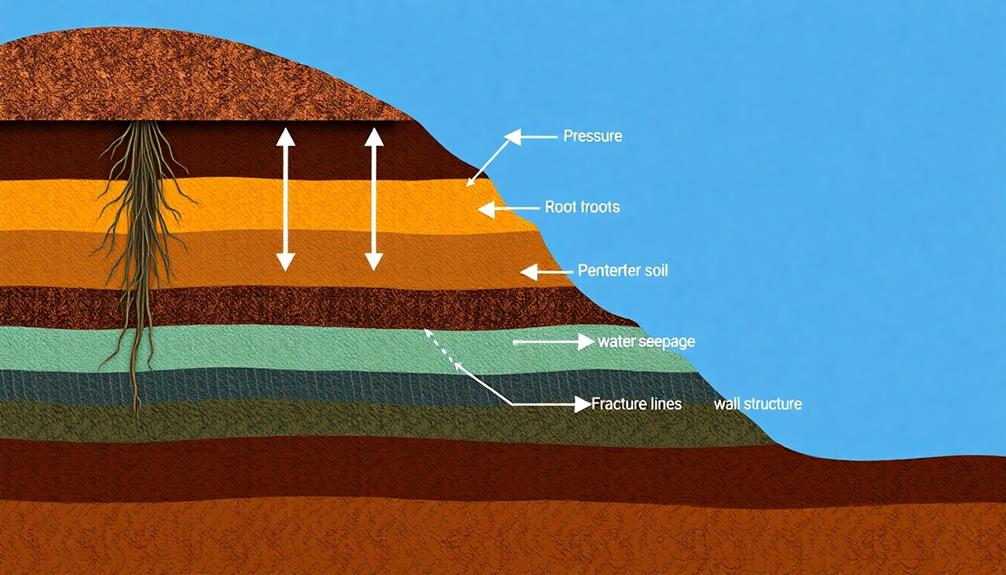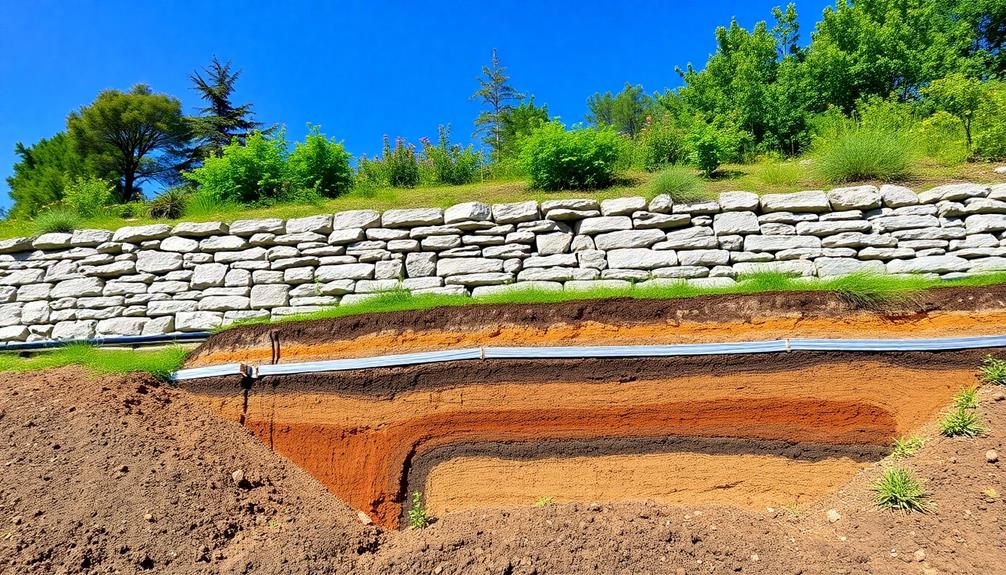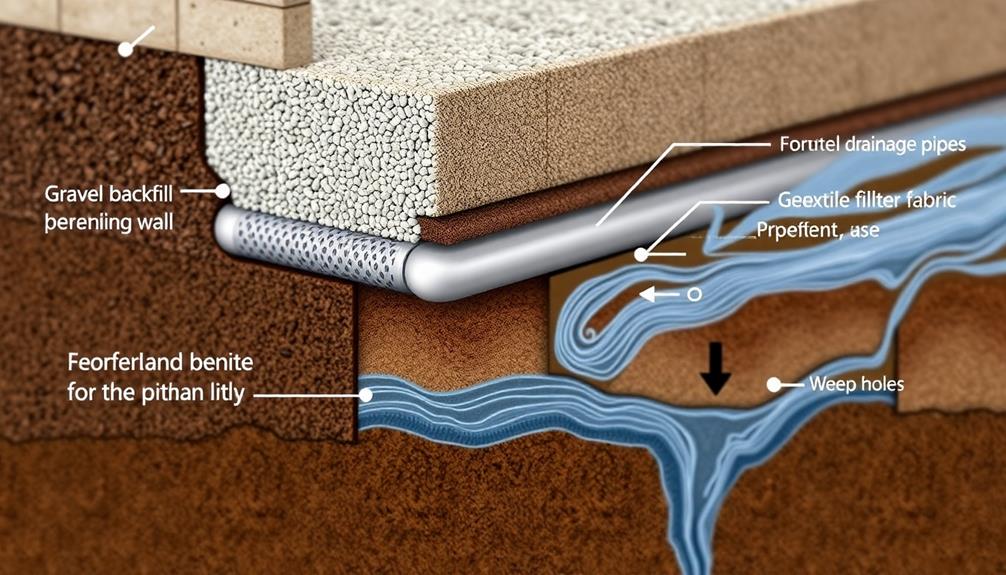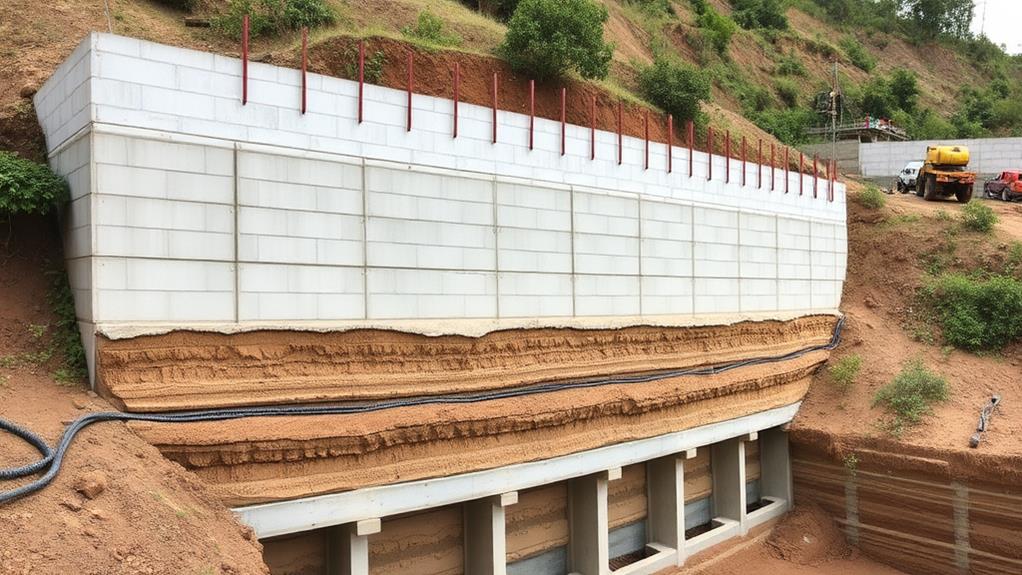Retaining wall stability is influenced by several vital factors that engineers and contractors must carefully consider. Soil pressure, including active and passive states, plays a fundamental role in wall design. Hydrostatic pressure from water accumulation behind the structure can exert significant lateral force, necessitating proper drainage systems. Surcharge loads from nearby structures or traffic increase lateral earth pressure, potentially leading to wall deformation or failure. Effective drainage design, including weep holes and filter fabric selection, is indispensable for long-term stability. Additionally, proper water diversion techniques help mitigate erosion and maintain wall integrity. Understanding these factors is essential for ensuring the longevity and safety of retaining structures.
Table of Contents
ToggleWalls Contractor Highlights
- Soil type and properties significantly influence lateral earth pressure and overall wall stability.
- Proper drainage systems are crucial to manage hydrostatic pressure and prevent water accumulation behind the wall.
- Surcharge loads from nearby structures or traffic can increase lateral pressure and affect wall stability.
- Wall design, including material choice, reinforcement, and dimensions, impacts its ability to withstand pressure.
- Regular maintenance and monitoring are essential to identify and address potential stability issues early.
Soil Pressure Behind Structure

The soil pressure behind a retaining wall markedly influences its stability, with active and passive pressures playing pivotal roles in the structure's performance. Hydrostatic pressure, resulting from groundwater accumulation, exerts additional forces that must be carefully considered in the wall's design and drainage systems.
Limestone retaining walls offer an attractive and customizable solution for managing soil pressure while providing long-term stability. These walls can be constructed using reconstituted or naturally quarried blocks, offering versatility in design and function.
Additionally, surcharge loads, such as nearby buildings or vehicular traffic, can substantially increase the lateral earth pressure, necessitating appropriate adjustments in the wall's structural capacity and reinforcement to maintain long-term stability.
Active vs. Passive Pressure
Soil pressure dynamics play an essential role in retaining wall stability, with active and passive pressures representing two distinct states of stress. Active pressure occurs when the soil mass behind the wall moves away from the retained earth, resulting in a minimal lateral force exerted on the structure. This condition typically arises when the wall begins to tilt or move outward, allowing the soil to expand slightly.
Conversely, passive pressure develops when the wall moves towards the retained soil, compressing it and generating a much higher lateral force.
Understanding these pressure states is pivotal for engineers and contractors involved in retaining wall design and construction. Active pressure represents the minimum force the wall must withstand to maintain stability, while passive pressure signifies the maximum resistance the soil can provide against movement. The interplay between these forces determines the overall stability of the retaining structure.
Factors such as soil type, moisture content, and compaction levels influence the magnitude of both active and passive pressures. By accurately calculating these forces and incorporating appropriate safety factors, designers can guarantee that retaining walls effectively resist soil loads and maintain long-term stability in various environmental conditions.
Hydrostatic Pressure Effects
Hydrostatic pressure exerts a substantial influence on retaining wall stability, complementing the active and passive soil pressures previously discussed. This pressure results from the accumulation of water behind the retaining structure, typically due to inadequate drainage or water table fluctuations. As water accumulates, it exerts a lateral force on the wall, increasing the overall load and potentially compromising its structural integrity.
To mitigate the effects of hydrostatic pressure, engineers implement various drainage systems. These may include weep holes, perforated pipes, or granular backfill materials that facilitate water movement away from the wall. Such measures are indispensable for maintaining long-term stability and preventing water-related damage.
Additionally, waterproofing membranes can be applied to the wall's backface to further reduce water infiltration. It merits attention that hydrostatic pressure can vary seasonally, with higher pressures often occurring during periods of increased precipitation or snowmelt. Consistent monitoring and maintenance of drainage systems are essential to guarantee their continued effectiveness in managing hydrostatic pressure. By addressing this pivotal factor, retaining wall designers can substantially enhance the structure's longevity and performance, providing peace of mind for property owners and ensuring public safety.
Surcharge Load Impact
Another essential factor influencing retaining wall stability is the surcharge load impact, which arises from additional soil pressure behind the structure. This pressure can result from various sources, including nearby buildings, vehicular traffic, or stockpiled materials. As professionals in the field, we must carefully consider these loads when designing and constructing retaining walls to guarantee long-term stability and safety.
The surcharge load impact can substantially affect a retaining wall's performance in several ways:
- Increased lateral earth pressure, potentially leading to wall deformation or failure
- Reduced factor of safety against overturning and sliding
- Amplified settlement of the retained soil, causing potential damage to adjacent structures
To mitigate these risks, engineers employ various design strategies, such as increasing wall thickness, incorporating additional reinforcement, or implementing drainage systems. It's indispensable to accurately assess the magnitude and distribution of surcharge loads through thorough site investigations and geotechnical analyses. By addressing surcharge load impacts proactively, we can enhance the longevity and reliability of retaining walls, ensuring they continue to serve their intended purpose effectively while maintaining the safety and integrity of surrounding structures and infrastructure.
Benefits

Retaining walls offer numerous benefits beyond their primary function of soil retention. These structures substantially enhance property value by creating usable space on sloped terrain, allowing for improved land utilization in areas that might otherwise be challenging to develop.
Limestone wall installation provides an elegant and natural look while offering excellent support and erosion prevention. Additionally, retaining walls serve as effective erosion control measures, preventing soil loss and water runoff, while simultaneously providing opportunities for aesthetic landscape enhancement through creative designs and plantings.
Enhanced Property Value
How can a well-designed retaining wall enhance property value? A thoughtfully constructed retaining wall not only serves functional purposes but also contributes appreciably to the aesthetic appeal and overall worth of a property. By creating usable space and mitigating erosion concerns, these structures can transform challenging landscapes into valuable assets.
Retaining walls offer numerous benefits that can increase a property's market value:
- Improved curb appeal, creating a visually striking focal point that sets your property apart from others in the neighborhood
- Expanded usable outdoor space, allowing for the creation of terraced gardens, patios, or additional living areas
- Enhanced erosion control and improved drainage, protecting your investment and reducing long-term maintenance costs
When professionally designed and constructed, retaining walls can seamlessly integrate with existing landscaping, creating a cohesive and attractive outdoor environment. This integration can lead to increased interest from potential buyers, ultimately driving up the property's value. Additionally, the added functionality and reduced maintenance requirements associated with well-built retaining walls can be significant selling points, appealing to discerning homeowners who appreciate both form and function in their outdoor spaces.
Improved Land Utilization
Beyond enhancing property value, retaining walls offer significant benefits with respect to improved land utilization. These structures enable property owners to maximize the usable area of their land by creating level surfaces on otherwise sloping terrain. By effectively managing elevation changes, retaining walls transform previously unusable or difficult-to-access portions of a property into functional spaces for various purposes.
In residential settings, retaining walls can create additional outdoor living areas, such as patios, gardens, or play spaces. For commercial properties, these structures facilitate the development of parking lots, walkways, or expanded building footprints. In agricultural contexts, retaining walls help in terracing hillsides, increasing arable land and improving irrigation efficiency.
In addition, retaining walls play a vital role in erosion control, preserving valuable topsoil and preventing runoff-related issues. By stabilizing slopes and redirecting water flow, these structures contribute to long-term land sustainability. The improved land utilization afforded by retaining walls not only optimizes space but also enhances the overall functionality and value of the property. Similarly, they represent a strategic investment for landowners seeking to maximize the potential of their real estate assets.
Erosion Control Measures
Effective erosion control is a primary benefit of well-designed retaining walls. These structures play a vital role in mitigating soil erosion, particularly on sloped terrains or in areas prone to heavy rainfall. By stabilizing soil and redirecting water flow, retaining walls serve as a robust defense against the gradual wearing away of land surfaces.
Implementing erosion control measures through retaining walls offers several advantages for property owners and communities:
- Preservation of valuable topsoil, ensuring the longevity of landscapes and agricultural productivity
- Protection of water quality by reducing sediment runoff into nearby streams, rivers, and lakes
- Enhancement of property aesthetics and value by preventing unsightly erosion scars and maintaining landscape integrity
Retaining walls, when properly constructed and maintained, provide long-term erosion control solutions that benefit both individual landowners and the broader environment. These structures utilize various engineering techniques to manage water drainage, soil compaction, and vegetation integration, creating a thorough approach to erosion prevention. By incorporating erosion control measures into retaining wall design, we can collectively safeguard our land resources, protect infrastructure, and maintain the ecological balance of our surroundings for generations to come.
Aesthetic Landscape Enhancement
Retaining walls offer more than just functional benefits; they can markedly enhance the aesthetic appeal of landscapes. These structures provide an opportunity to create visually striking features that complement the natural terrain while serving their primary purpose of soil retention. By incorporating materials that harmonize with the surrounding environment, such as natural stone or textured concrete, retaining walls can seamlessly blend into the landscape, creating a cohesive and attractive outdoor space.
The design possibilities for retaining walls are extensive, allowing for the integration of various elements that elevate the overall aesthetic. Tiered walls can create engaging multi-level gardens, providing opportunities for diverse plantings and visual interest. Incorporating built-in seating or planters into the wall structure adds functionality while enhancing the visual appeal. Proper lighting techniques can accentuate the wall's texture and form, creating dramatic effects during evening hours. Additionally, the use of cascading plants or climbing vines can soften the wall's appearance, integrating it further into the landscape. By carefully considering these aesthetic aspects, retaining walls can transform from mere functional elements into focal points that notably contribute to the overall beauty and value of the property.
Drainage System Design Considerations

Effective drainage system design is pivotal for maintaining retaining wall stability and preventing water-related damage. Key considerations include implementing proper water diversion techniques, strategically placing weep holes, and selecting appropriate filter fabric materials. The following table outlines essential elements of drainage system design for retaining walls, highlighting the importance of each component in ensuring long-term structural integrity:
| Component | Purpose | Design Considerations |
|---|---|---|
| Water Diversion | Redirect surface runoff | Slope grading, swales, berms |
| Weep Holes | Allow water passage | Spacing, size, location |
| Filter Fabric | Prevent soil erosion | Material type, permeability |
| Drainage Pipe | Collect and channel water | Diameter, slope, placement |
| Backfill Material | Facilitate water movement | Granular composition, compaction |
Proper Water Diversion Techniques
Proper water diversion is a critical aspect of retaining wall design that profoundly impacts long-term stability and performance. Effective water management techniques prevent hydrostatic pressure buildup behind the wall, which can lead to structural failure over time. Implementing an ideal drainage system, including both surface and subsurface components, is essential for ensuring the wall's longevity and functionality.
To achieve preferred water diversion, designers and engineers must consider the following techniques:
- Install a perforated drain pipe at the base of the wall to collect and redirect subsurface water away from the structure, safeguarding its foundation and preventing erosion.
- Incorporate a layer of free-draining backfill material behind the wall to facilitate water movement and reduce the potential for soil saturation and pressure accumulation.
- Implement surface grading and swales to direct runoff away from the wall's vicinity, minimizing water infiltration and potential soil destabilization.
Weep Hole Placement
Weep holes play a central role in a retaining wall's drainage system design, serving as essential components for relieving hydrostatic pressure and preventing water accumulation behind the structure. These strategically placed openings allow water to escape from behind the wall, reducing the potential for soil saturation and subsequent instability. When designing weep hole placement, engineers must consider several factors to guarantee optimal performance.
The spacing and size of weep holes are pivotal considerations. Typically, weep holes should be placed at regular intervals along the wall's length and height, with a general recommendation of one weep hole per 4 to 6 square feet of wall face. The diameter of these openings usually ranges from 3 to 4 inches, depending on the wall's height and anticipated water volume. It's imperative to position weep holes at the wall's base and at various elevations to accommodate fluctuating groundwater levels. Additionally, incorporating a proper drainage medium, such as gravel or geotextile fabric, behind the wall helps direct water towards the weep holes, enhancing their effectiveness. By carefully planning weep hole placement, engineers can considerably improve a retaining wall's longevity and structural integrity.
Filter Fabric Selection
While weep holes provide an essential outlet for water, the selection of appropriate filter fabric is another key element in designing an effective drainage system for retaining walls. Filter fabric, also known as geotextile, serves as a barrier between the soil and the drainage material, preventing fine particles from clogging the system while allowing water to pass through. The choice of filter fabric depends on several factors, including soil type, hydraulic conditions, and structural requirements.
When selecting filter fabric for your retaining wall project, consider the following pivotal aspects:
- Permeability: Guarantee the fabric allows sufficient water flow while retaining soil particles.
- Strength: Choose a fabric that can withstand the pressure exerted by the soil and backfill material.
- Durability: Opt for a fabric resistant to degradation from environmental factors and chemical exposure.
Engineers and contractors must carefully evaluate these factors to select the most appropriate filter fabric for each specific retaining wall application. The proper selection and installation of filter fabric contribute markedly to the long-term stability and performance of the retaining wall structure. By incorporating high-quality filter fabric into the drainage system design, we can effectively manage water flow and prevent soil erosion, ultimately enhancing the wall's structural integrity and longevity.
Walls Contractor FAQ
How Often Should Retaining Walls Be Inspected for Potential Issues?
Regular inspections are vital for retaining wall longevity. Experts recommend annual checks for residential walls and bi-annual inspections for commercial structures. However, more frequent assessments may be necessary after severe weather events or if signs of instability appear.
What Are Signs That a Retaining Wall Is Failing?
Signs of a failing retaining wall include visible bulging, leaning, or cracking, soil erosion behind the wall, water seepage, and separation between wall sections. Regular inspections can help us identify these issues early and maintain our property's safety.
Can Vegetation Growth Impact Retaining Wall Stability?
Vegetation growth can indeed impact retaining wall stability. While some plants may help stabilize soil, aggressive root systems can cause structural damage. It is crucial to opt for suitable vegetation and preserve proper landscaping to safeguard wall integrity.
Are There Specific Building Codes for Retaining Wall Construction?
Yes, there are specific building codes for retaining wall construction. These codes vary by location but typically address factors like height, materials, drainage, and structural integrity. Adherence guarantees safety and longevity for our community's infrastructure projects.
How Do Earthquakes Affect Retaining Wall Stability and Design Considerations?
Earthquakes profoundly impact retaining wall stability, necessitating specialized design considerations. Engineers incorporate seismic loads, flexible materials, and reinforcement techniques to enhance resilience. We prioritize safety by implementing stringent seismic design standards in earthquake-prone regions, ensuring community protection.







